Equivalent properties for an undirected graph:
- The graph is a tree;
- The graph is connected and has at most n-1 edges (where n is the number of vertices);
- The graph has no cycles and has at least n-1 edges;
- The graph is connected and minimal (if we remove any edge, it becomes non-connected);
- The graph has no cycles and is maximal (if we add any edge, it closes a cycle);
- For any pair of vertices, there is a unique path connecting them.
The minimum spanning tree problem
Given a graph with non-negative costs, find a tree with the same vertices and a subset of the edges of the original graph (a spanning tree) of minimum total cost.
Example: input graph:

There are two well-known algorithms for solving this problem: Kruskal's algorithm and Prim's algorithm.Kruskal's algorithm
Idea
The idea is to start with a graph with all the vertices and no edges, and then to add edges that do not close cycles. This way, as the algorithm progresses, the graph will consist in small trees (it will be what is called a forest - a graph with no cycles, meaning that its connected components are trees), and those trees are joined together to form fewer and larger trees, until we have a single tree spanning all the vertices. In doing all the above, we use the edges in increasing order of their cost.
The basic algorithm
Input:
G : undirected graph with costs
Output:
edges : a collection of edges, forming a minimum cost spanning tree
Algorithm:
e0,...,em-1 = list of edges sorted increasing by cost
edges = ∅
for i from 0 to m-1 do
if edges ∪ {ei} has no cycles then
edges.add(ei)
end if
end for
| Edge | Cost |
|---|---|
| 1-2* | 1 |
| 2-6* | 1 |
| 4-5* | 1 |
| 1-6 | 2 |
| 1-3* | 2 |
| 3-6 | 2 |
| 1-4* | 3 |
| 3-5 | 3 |
| 3-4 | 4 |
| 5-6 | 5 |
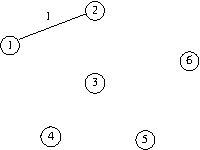
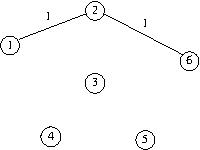
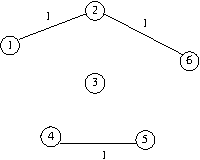
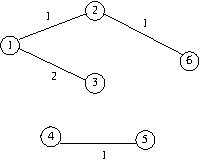
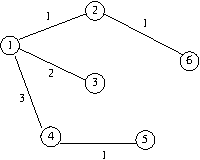
Issue with the basic algorithm
The difficult part here is how to test the existence of cycles. There is a much easier way: to keep track of the connected components of edges, and to notice that a cycle is formed when adding a new edge if and only if the endpoints of the edge are in the same component.
Keeping track of the connected components is an interesting problem in itself.
Ideas:
- Each component is kept as a rooted tree (independent of the tree of the original graph);
- Each component has a representative vertex that is the root of the tree; each vertex in the component has a pointer to its parent;
- Therefore, to test if two vertices are in the same component, we go from each of them up to the representative of its component, and we verify if we reach the same vertex;
- When joining two components, we place the representative of one component as a child of the representative of the other. This way, all vertices in the first component are moved to the second.
- There are 2 optimizations to prevent the height of the rooted tree to increase:
- When joining two components of different heights, the representative of the shortest is set as child of the representative of the tallest (never vice-versa);
- When retrieving the representative, we compress the path, that is, we place all the vertices along the path to the representative as direct children of the representative.
Proof of correctness
The proof is a clasical proof for a greedy algorithm: we compare the Kruskal's solution with the optimal solution for the problem, find the first difference, and modify the optimal solution, without loosing the optimality, so that to match better the Kruskal's solution. By repeating the above step, we turn the optimal solution into Kruskal's solution without loosing the optimality, thus proving that Kruskal's solution is optimal.
Prim's algorithm
Idea
Prim's algorithm is similar to Kruskal's algorithm; however, instead of starting with lots of trees and joining them together, Prim's algorithm starts with a single tree consisting in a single vertex, and then grows it until it covers all the vertices. At each step, an edge is added, connecting an exterior vertex to the tree. Among all the edges connecting a vertex outside the tree with one in the tree, it is choosen the edge of smallest cost.
The algorithm
Input:
G : directed graph with costs
Output:
edges : a collection of edges, forming a minimum cost spanning tree
Algorithm:
PriorityQueue q
Dictionary prev
Dictionary dist
edges = ∅
choose s in X arbitrarily
vertices = {s}
for x in N(s) do
dist[x] = cost(x, s)
prev[x] = s
q.enqueue(x, d[x]) // second argument is priority
while not q.isEmpty() do
x = q.dequeue() // dequeues the element with minimum value of priority
if x ∉ vertices then
edges.add({x, prev[x]})
vertices.add(x)
for y in N(x) do
if y not in dist.keys() or cost(x,y) < dist[y] then
dist[y] = cost(x, y)
q.enqueue(y, dist[y])
prev[y] = x
end if
end for
end if
end while
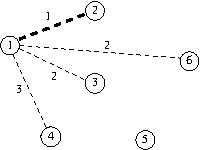
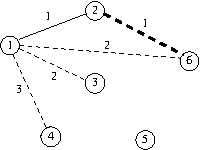
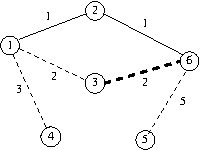
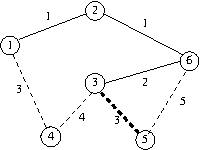
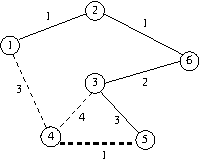
2020-05-15